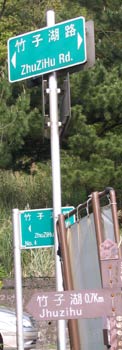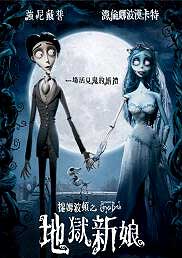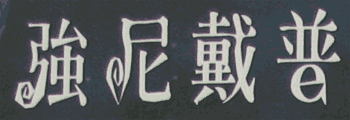 Less than 10 years ago the romanization on Taipei’s street signs was a complete mess. The “standard,” such as it was, was the inherently bad bastardized Wade-Giles; but misspellings were abundant, so much so that even some individual intersections had signs with several different spellings. It was the sort of thing foreigners in Taiwan loved to point out. Since almost all of those signs are now gone — and good riddance! — I offer up this lesser sample, taken about ten days ago when my wife and I went walking on Yangming Shan to see the sakura and calla lilies.
Less than 10 years ago the romanization on Taipei’s street signs was a complete mess. The “standard,” such as it was, was the inherently bad bastardized Wade-Giles; but misspellings were abundant, so much so that even some individual intersections had signs with several different spellings. It was the sort of thing foreigners in Taiwan loved to point out. Since almost all of those signs are now gone — and good riddance! — I offer up this lesser sample, taken about ten days ago when my wife and I went walking on Yangming Shan to see the sakura and calla lilies.
The sign on the top, reading “ZhuZiHu Rd.”, is in a mix of Hanyu Pinyin and English (Rd.), though, like other Hanyu Pinyin signs in Taipei, it uses InTerCaPiTaLiZaTion for individual syllables, which is wrong, wrong, wrong. (It should be Zhuzihu or Zhuzi Hu, not ZhuZiHu.) The trail marker at the bottom marked “Jhuzihu” is in misspelled Tongyong Pinyin; in Tongyong it should be written “Jhuzihhu”.
 The reason for the different spellings here is almost certainly that the road, being within Taipei, is labeled in Hanyu Pinyin, whereas the trail marker, for a trail within Yangming Shan National Park, was put up by the central government and is thus in Tongyong Pinyin — well, almost. The misspelled Tongyong in the sign isn’t just a one-off, either. All of the Tongyong-ish signs I saw in the area are misspelled in the same way. See, for example, the sign at right. (The arrows, by the way, are both correct: The road is a loop.)
The reason for the different spellings here is almost certainly that the road, being within Taipei, is labeled in Hanyu Pinyin, whereas the trail marker, for a trail within Yangming Shan National Park, was put up by the central government and is thus in Tongyong Pinyin — well, almost. The misspelled Tongyong in the sign isn’t just a one-off, either. All of the Tongyong-ish signs I saw in the area are misspelled in the same way. See, for example, the sign at right. (The arrows, by the way, are both correct: The road is a loop.)
Note, also, how the “i” in the second example below is printed incorrectly, with the top of the dot lining up with the tops of the other lowercase letters. I’ve been seeing increasing instances of this particular typographical monstrosity, which puzzles me because it seems like the sort of error that someone has to go out of their way to make.
Those familiar with Taipei may have noticed something odd about the name Zhuzihu: It is not bisyllabic. Indeed, it is the only road name of Sinitic origin within Taipei to have more than two syllables. (The only other two such names are loans from English (Roosevelt) and a language of one of Taiwan’s tribes (Ketagelan). See Taipei street names and the monosyllabic myth.)
 Closer examination, however, reveals that Zhuzihu is based upon a bisyllabic name after all. Zhuzi Hu means “Bamboo Lake” (Zhúzi Hú / 竹子湖). The only particular reason for writing it solid (Zhuzihu) rather than as “Zhuzi Hu” is that there’s no actual hu (lake) there anymore. (It was more like a marsh, anyway.) Come to think of it, I don’t remember seeing any bamboo there, either. A case could be made for writing it either way: Zhuzi Hu or Zhuzihu
Closer examination, however, reveals that Zhuzihu is based upon a bisyllabic name after all. Zhuzi Hu means “Bamboo Lake” (Zhúzi Hú / 竹子湖). The only particular reason for writing it solid (Zhuzihu) rather than as “Zhuzi Hu” is that there’s no actual hu (lake) there anymore. (It was more like a marsh, anyway.) Come to think of it, I don’t remember seeing any bamboo there, either. A case could be made for writing it either way: Zhuzi Hu or Zhuzihu
By the way, I wrote the Taipei City Government to have it correct its Web site on the calla lilies. The problem was that the Tongyong Pinyin spelling, Jhuzihhu, was used rather than the Hanyu Pinyin spelling, Zhuzihu. More than a week passed without any changes. Today, however, I noticed that some (but not all or even most) of the spellings had been changed — to another wrong spelling! Now some of the time the Web site gives the Tongyong Pinyin version, Jhuzihhu, and some of the time it gives Zhuzihhu, that latter having one h too many for correct Hanyu Pinyin. No one has yet responded to my message.

 The cover for the DVD for Tim Burton’s Corpse Bride (Dìyù Xīnniáng / 地獄新娘 / “Hell Bride”) has what for me is an arresting usage: the roman letter “e” has been incorporated into a Chinese character.
The cover for the DVD for Tim Burton’s Corpse Bride (Dìyù Xīnniáng / 地獄新娘 / “Hell Bride”) has what for me is an arresting usage: the roman letter “e” has been incorporated into a Chinese character.![Tim Burton's ['Corpse Bride'] -- in Chinese characters](https://pinyin.info/news/news_photos/2006/03/corpse_bride.gif)

 Less than 10 years ago the romanization on Taipei’s street signs was a complete mess. The “standard,” such as it was, was the inherently bad
Less than 10 years ago the romanization on Taipei’s street signs was a complete mess. The “standard,” such as it was, was the inherently bad  The reason for the different spellings here is almost certainly that the road, being within Taipei, is labeled in Hanyu Pinyin, whereas the trail marker, for a trail within Yangming Shan National Park, was put up by the central government and is thus in Tongyong Pinyin — well, almost. The misspelled Tongyong in the sign isn’t just a one-off, either. All of the Tongyong-ish signs I saw in the area are misspelled in the same way. See, for example, the sign at right. (The arrows, by the way, are both correct: The road is a loop.)
The reason for the different spellings here is almost certainly that the road, being within Taipei, is labeled in Hanyu Pinyin, whereas the trail marker, for a trail within Yangming Shan National Park, was put up by the central government and is thus in Tongyong Pinyin — well, almost. The misspelled Tongyong in the sign isn’t just a one-off, either. All of the Tongyong-ish signs I saw in the area are misspelled in the same way. See, for example, the sign at right. (The arrows, by the way, are both correct: The road is a loop.)  Closer examination, however, reveals that Zhuzihu is based upon a bisyllabic name after all. Zhuzi Hu means “Bamboo Lake” (Zhúzi Hú / 竹子湖). The only particular reason for writing it solid (Zhuzihu) rather than as “Zhuzi Hu” is that there’s no actual hu (lake) there anymore. (It was more like a marsh, anyway.) Come to think of it, I don’t remember seeing any bamboo there, either. A case could be made for writing it either way: Zhuzi Hu or Zhuzihu
Closer examination, however, reveals that Zhuzihu is based upon a bisyllabic name after all. Zhuzi Hu means “Bamboo Lake” (Zhúzi Hú / 竹子湖). The only particular reason for writing it solid (Zhuzihu) rather than as “Zhuzi Hu” is that there’s no actual hu (lake) there anymore. (It was more like a marsh, anyway.) Come to think of it, I don’t remember seeing any bamboo there, either. A case could be made for writing it either way: Zhuzi Hu or Zhuzihu